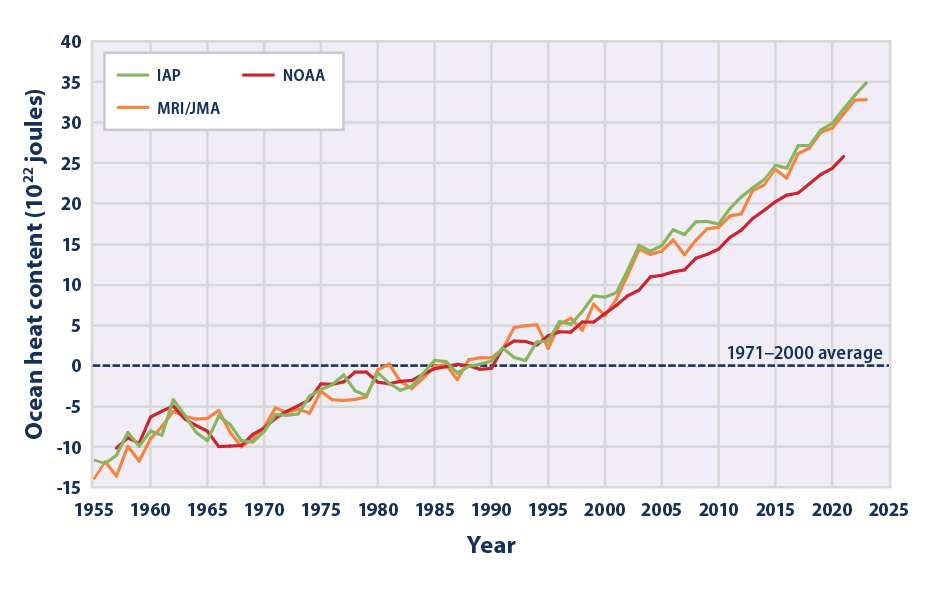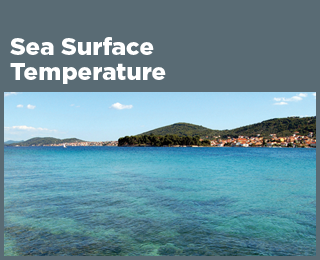Climate Change Indicators: Ocean Heat
This indicator describes trends in the amount of heat stored in the world’s oceans.
Key Points
- In four different data analyses, the long-term trend shows that the top 700 meters of the oceans have become warmer since 1955 (see Figure 1). All three analyses in Figure 2 show additional warming when the top 2,000 meters of the oceans are included. These results indicate that the heat absorbed by surface waters extends to much lower depths over time.
- Although concentrations of greenhouse gases have risen at a relatively steady rate over the past few decades (see the Atmospheric Concentrations of Greenhouse Gases indicator), the rate of change in ocean heat content can vary from year to year (see Figures 1 and 2). Year-to-year changes are influenced by events such as volcanic eruptions and recurring ocean-atmosphere patterns such as El Niño.
Background
When sunlight and energy trapped by greenhouse gases reach the Earth’s surface, the world’s oceans absorb some of this energy and store it as heat. This heat is initially absorbed at the surface, but some of it eventually spreads to deeper waters. Currents also move this heat around the world. Water has a much higher heat capacity than air, meaning the oceans can absorb larger amounts of heat energy with only a slight increase in temperature.
The total amount of heat stored by the oceans is called “ocean heat content,” and measurements of water temperature reflect the amount of heat in the water at a particular time and location. Ocean temperature plays an important role in the Earth’s climate system—particularly sea surface temperature (see the Sea Surface Temperature indicator)—because heat from ocean surface waters provides energy for storms and thereby influences weather patterns.
Increasing greenhouse gas concentrations are trapping more energy from the sun. Because changes in ocean systems occur over centuries, the oceans have not yet warmed as much as the atmosphere, even though they have absorbed more than 90 percent of the Earth’s extra heat over the last half-century,1 and even as the rate of ocean heat uptake has doubled since 1993.2 If not for the large heat-storage capacity provided by the oceans, the atmosphere would warm more rapidly.3 Increased heat absorption also changes ocean currents because many currents are driven by differences in temperature, which cause differences in density. These currents influence climate patterns and sustain ecosystems that depend on certain temperature ranges.
Because water expands slightly as it gets warmer, an increase in ocean heat content will also increase the volume of water in the ocean, which is one of the major causes of the observed increases in sea level (see the Sea Level indicator). For all these reasons, ocean heat content is one of the most important indicators tracking the causes and responses of a changing climate.
About the Indicator
This indicator shows trends in global ocean heat content from 1955 to 2023. Measurement data are available for the top 2,000 meters (nearly 6,600 feet) of the ocean, which accounts for nearly half of the total volume of water in the world’s oceans. This indicator also shows changes representative of the top 700 meters (nearly 2,300 feet) of the world’s oceans, where much of the observed warming has taken place. The indicator measures ocean heat content in joules, which are units of energy.
Organizations around the world have calculated changes in ocean heat content based on measurements of ocean temperatures at different depths. These measurements come from a variety of instruments deployed from ships and airplanes and, more recently, underwater robots. Thus, the data must be carefully adjusted to account for differences among measurement techniques and data collection programs. Figure 1 shows four independent interpretations of essentially the same underlying data for the top 700 meters of the ocean, and Figure 2 shows three independent interpretations for the top 2,000 meters of the ocean.
About the Data
Indicator Notes
Data must be carefully reconstructed and filtered for biases because of different data collection techniques and uneven sampling over time and space. Various methods of correcting the data have led to slightly different versions of the ocean heat trend line. Scientists continue to compare their results and improve their estimates over time. They also test their ocean heat estimates by looking at corresponding changes in other properties of the ocean. For example, they can check to see whether observed changes in sea level match the amount of sea level rise that would be expected based on the estimated change in ocean heat.
Data Sources
Data for this indicator were collected by the National Oceanic and Atmospheric Administration (NOAA) and other organizations around the world. The data were analyzed independently by researchers at NOAA, Australia’s Commonwealth Scientific and Industrial Research Organisation, China’s Institute of Atmospheric Physics, and the Japan Meteorological Agency’s Meteorological Research Institute.
Technical Documentation
References
1 IPCC (Intergovernmental Panel on Climate Change). (2021). Climate change 2021—The physical science basis: Working Group I contribution to the Sixth Assessment Report of the Intergovernmental Panel on Climate Change (V. Masson-Delmotte, P. Zhai, A. Pirani, S. L. Connors, C. Péan, S. Berger, N. Caud, Y. Chen, L. Goldfarb, M. I. Gomis, M. Huang, K. Leitzell, E. Lonnoy, J. B. R. Matthews, T. K. Maycock, T. Waterfield, O. Yelekçi, R. Yu, & B. Zhou, Eds.). Cambridge University Press. https://doi.org/10.1017/9781009157896
2 IPCC (Intergovernmental Panel on Climate Change). (2019). Summary for policymakers. In The ocean and cryosphere in a changing climate: Special report of the Intergovernmental Panel on Climate Change. Cambridge University Press. https://doi.org/10.1017/9781009157964.001
3 Levitus, S., Antonov, J. I., Boyer, T. P., Baranova, O. K., Garcia, H. E., Locarnini, R. A., Mishonov, A. V., Reagan, J. R., Seidov, D., Yarosh, E. S., & Zweng, M. M. (2012). World ocean heat content and thermosteric sea level change (0–2000 m), 1955–2010. Geophysical Research Letters, 39(10), 2012GL051106. https://doi.org/10.1029/2012GL051106
4 IEA (International Energy Agency). (2021). Key world energy statistics 2021. www.iea.org/reports/key-world-energy-statistics-2021
5 CSIRO (Commonwealth Scientific and Industrial Research Organization) (2024). Update to data originally published in Domingues, C. M., Church, J. A., White, N. J., Gleckler, P. J., Wijffels, S. E., Barker, P. M., & Dunn, J. R. (2008). Improved estimates of upper-ocean warming and multi-decadal sea-level rise. Nature, 453(7198), 1090–1093. https://doi.org/10.1038/nature07080
6 IAP (Institute of Atmospheric Physics). (2024). Update to data originally published in Cheng, L., Trenberth, K. E., Fasullo, J., Boyer, T., Abraham, J., & Zhu, J. (2017). Improved estimates of ocean heat content from 1960 to 2015. Science Advances, 3(3), e1601545. https://doi.org/10.1126/sciadv.1601545
7 MRI/JMA (Meteorological Research Institute/Japan Meteorological Agency). (2024). Global ocean heat content. www.data.jma.go.jp/gmd/kaiyou/english/ohc/ohc_global_en.html
8 NOAA (National Oceanic and Atmospheric Administration). (2024). Global ocean heat and salt content: Seasonal, yearly, and pentadal fields. www.nodc.noaa.gov/OC5/3M_HEAT_CONTENT









